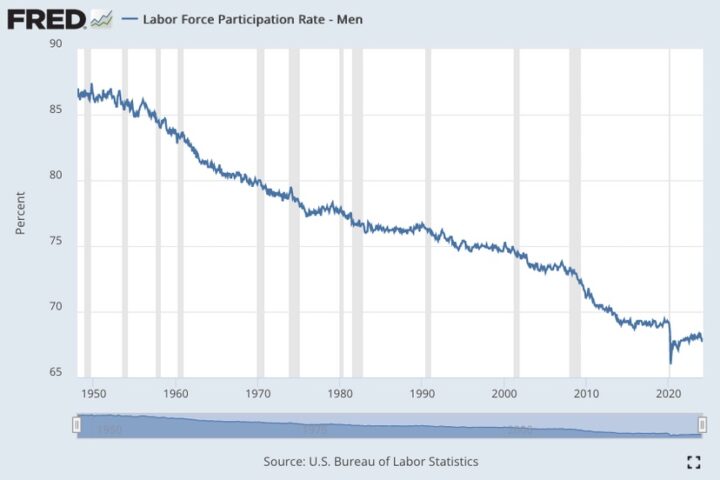A large number of American men of prime working age — between 25 and 54 years old — are not working or even looking for work… In 1953, 98% of men in that age range had a job or were looking for one. That number has fallen ever since. Today, 7.2 million men have essentially dropped out of the workforce…
— from a story on CBS Mornings, January 2023.
And things have not improved since last year.
The most recent graph from the Federal Reserve shows that only 68% of American men are working, as of March 2024.
Even men of “prime working age” have stopped showing up for work.

What are these non-workers doing? According to CBS News:
How are non-working men between 25 and 54 spending their time? On average, nearly seven hours each weekday are dedicated to leisure time — relaxing, playing games and watching TV, according to data from the Bureau of Labor Statistics from 2021.
I personally wouldn’t put those activities in the same sentence. Relaxing and watching TV are not nearly the same as playing a video game, which requires your full attention and an incredible amount of skill. I have nothing but admiration for someone who can play a video game for seven hours a day.
However, I have to wonder… how he is paying for his beer?
It’s possible he has a wife or girlfriend who actually has a job, and who’s willing to run to the liquor store, or the grocery store. (Lots of grocery stores in Colorado now sell beer, which has been convenient.)
Unlike the situation with American men, the participation of American women in the workforce has been on a healthy upward trend, with a slight downturn starting in about 2010.

While this cultural shift has been good for the designers of video games, it’s been hard on the capitalists who are used to paying starvation wages and still having a robust workforce. Last February, there were nearly 1.4 jobs for every unemployed job seeker. The number of unfilled American jobs was nearly 8.8 million as of the last business day of February, the most recent month on record.
From a recent CBS Mornings report:
“We have more jobs than we have people for — about one and a half jobs for every one worker,” said Jay Timmons, who leads the National Association of Manufacturers, an advocacy group based in Washington, D.C., that represents 14,000 manufacturers across the country.
Timmons describes all this as a profound problem for the companies he represents. The No. 1 challenge for most of them right now is filling open jobs.
“I never thought I’d be able to say that,” he told CBS News. “But now it’s kind of an all hands on deck. We’ve got to fill these jobs that are open.”
Obviously, the main problem is that we have evolved as a species, to where video games have become more fun than working at a manufacturing job.
Although maybe that’s not obvious to everyone.
But there’s another obvious problem, when we look at the graphs from the Federal Reserve. Back in 1950, less than 35% of American women were working at a job. And more than 85% of men were employed.
But the capitalist employers found they could pay women less than they were paying men, for the same job.
By 2010, 60% of women were working jobs, and only about 70% of men were employed. Things have gotten even worse for the employers since then. Fewer women, and fewer men, working.
We’re hip to the jive.
During the 2020 presidential campaign, Joe Biden promised to create a million new manufacturing jobs. He hasn’t yet hit that mark; as of March, the U.S. had added 768,000 manufacturing jobs since Biden took office. But what he totally forgot to promise, was people willing to work those jobs.
Of course, most of these numbers and statistics are coming from the government, which, ipso facto, means they are wild guesses. I personally don’t know a single person who spends seven hours a day playing video games.
Seven hours a day scrolling through news websites? Possibly.
When you’ve got leisure time, you gotta spend it.
Underrated writer Louis Cannon grew up in the vast American West, although his ex-wife, given the slightest opportunity, will deny that he ever grew up at all. You can read more stories on his Substack account.

